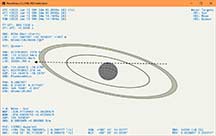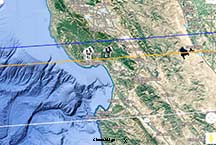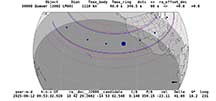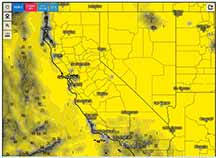


Wind velocities on June 8.

Alt=38, Az=182
This Quaoar event actually has us inside the shadow path, barely inside the northern limit. Thinking for our 8SE telescope setups - The target star is magnitude 15.7, alt= 38 degrees. At 38 degrees, the star will be 0.15 magnitude dimmer than if it were at alt=66 degrees. So, figure 15.8 magnitude, and to look like a 13.5 mag star would require 7x times longer integration. So if 16x will show the star clearly, we'd need 16x times 7 = 112x. Close to the 128x setting in the Watec. Can we integrate that long and not have a total white out? Perhaps if the focal reducer were removed, we might? Worth a try.
A much better prospect would be at the 36" and 14" scopes on Chews Ridge. Unfortunately, these are still in upgrade mode and not available for use. But at Chews Ridge the air will be more transparent, and hence less lit by the large moon. The seeing will be sub-arcsec likely, allowing better illumination per pixel. The event is only 14 degrees from the 99% moon. The longer focal length will further darken the skies. And the chord will be deeper into the shadow yet still give a long grazing incidence on the possible atmospheric extinction by any Quaoar atmosphere. At the sub -400F temperatures at Quaoar, however, nitrogen freezing will reduce prospects of any atmosphere, but the grazing incidence can provide better information on this.
The telescope is undergoing repairs and improvements. I have secured approval for Van H for our trip. Dan says we can go to MIRA even if the scope isn't ready, and set up our own scopes and the MIRA 14" from Marina as well, if they can get it ported up the mountain.
Alt=38, due south
 |
 |
 |
Wind velocities on June 8. |
 |
Charts in this first row below are for pre-event ID on eve of June 10 at 11:59pm in 8SE telescopes w/ f/3.3 reducer as per usual. Right after the Euphrosyne event. LCD charts for Watec 910hx. Note the actual event will be a bit tilted from what you see below here, as here at midnight June 10 the target is Az=138, but on event night it's near Az=180. It turns out this faint Quaoar target is a UCAC4 star,
Star ID= UCAC4 376-138077
|
Standard LCD chart for Watec, with chip FOV the black interior box. The target at this scale is lost among the middle stars, so... |
LCD chart zoomed in more. You can see the Watec field width edges on the far edges of this image above |
SDSS Aladin chart, zoomed in to about half the width of our 8SE LCD charts, with same star pattern shown at left |
Kirk, Sandy and I joined Nelson and Dan at MIRA's OOS Observatory on Chews Ridge. Very difficult event, in strong 99% moonlight and whipping winds, made it very tough. When Kirk and I arrived at sunset, Dan had chosen a spot under the pine tree next to the tables overlooking the south. But the pine tree and small car did very little to break the wind, and after the process of setting up this ~500 lb (??) telescope and getting the equatorial mount aligned and calibrated, I decided we needed to move to a nook on the south side of the OOS building, which was well protected from the wind at that time, although in the weeds and old boards. It was another long process of trying to put the scope together on the mount, getting it approximately polar aligned, and then going through a sequence of 6 stars to center and align and make a mount model.
We did not get on-target till midnight. Locating the star field was harder than I'd hoped. The available eyepiece was very high power and a small fraction of the FOV of my charts. After about 40 minutes of moving the scope around and rotating the Watec and staring at stars, I finally found something I thought I recognized, and confirmed with more stars that yes that was where I thought. The target was still impossible to see. Lost in the moonlight. We were at f/11 and so the FOV was only about half the diameter of my LCD image I'd made for Kirk. Kirk got on target fairly efficiently, but he too could not see the target, which was 2 magnitude dimmer than the "bright" star very nearby.
Nelson said he'd many times used this battery for observing "all night" and thought it would last through the occultation time. I didn't ask about AC power on the move because I didn't think it was available from that side of the building. But, I was wrong, and Dan did string out an AC cord. But Nelson could not find any AC adapter to power his scope! So, we just trusted that we did have enough power in his beefy battery to let the scope track through 3am. All tuned, we then took a 90 minute sleep cycle to allow then getting up at 2:10am for the final approach to the 2:53am event.
I discovered when I got to the scope (I camped on the overlook as per the past) that the scope was not tracking. And the RA/Dec reading were indicating the scope had lost power during the nap. Battery exhausted. W/o finding an AC power line, I ran to the van and grabbed an Orion Dynamo. I'd brought all of them, from home. I found an adapter for a male 12VDC plug and got the scope re-powered. But, we needed to do the 6 star align and calibration procedure again, which took much time. Then, a GoTo the target and it turned out the GoTo wasn't that accurate. I again had to try to ID the tiny asterism visible with something on my charts. Time was too short, now, and I did not succeed in ID"ing the field until just after the event time. I was only able to ID the stars and get on-target for the event 5 minutes after the event was over. The Watec 32x FOV showed the brighter (top) of the 3 stars very close to the 13th mag brighest star in the little asterism shown at the target. The target itself was never visible even at 32x. However, I do note that the field was darker and the stars sharper and I could see the neighboring 14th mag star, barely. Worse, the wind had rotated a bit further out ot the west, and the target had moved west too, and the scope was seeing vibrations on every gust. I did not get anything recorded during the event.
I think if we'd had no wind, and I'd done 32x images, I could have stacked them effectively enough (Fourier finders) to reveal the target star wll enough to see an occultation lasting several seconds or more. However, I did do some recording after I did locate the target, just to help understand what was possible under these conditions.
Kirk on his 8SE did get a recording, but it will be very difficult to torture his data enough to reveal the target star.
Here's some images from the trip that are either relevant, or else just a good memory jog for this adventure...
I did not get on target until too late. But I did record some footage so as to help characterize what was possible, if the battery had not failed early.